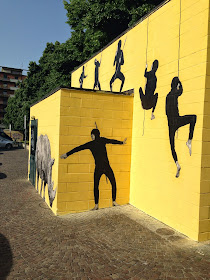Translation by Francesco Mazzaferro
CLICK HERE FOR ITALIAN VERSION
CLICK HERE FOR ITALIAN VERSION
Interview with Levalet
The Hunt
Bologna, CHEAP Festival, May 2015
As part of
the third edition of the Bologna CHEAP Festival, Festival of Street Poster Art,
the French poster artist Levalet (born as Charles Leval) has produced an art
creation on one of the buildings of access to the parking lot of Piazza
Azzarita in Bologna. The title of the installation is The Hunt.
The Hunt is composed of about thirty hand-painted figures
in black ink on paper, installed on the wall with the technique of paste up.
You will
find below images of the work.
At this
link, moreover, you can find the notes (in Italian) on The Hunt as published by the CHEAP organizing team:
To us the
work of Levalet seemed particularly intriguing, which is why we decided to
contact and propose him an interview. We thank him for having accepted (and equally,
we would like to express gratitude to the organizers of CHEAP for establishing
the contact). (Giovanni Mazzaferro)
INTERVIEW WITH LEVALET
Q. Why, in the realm of Street Art, did you
choose the method of ink drawing on poster? Can we say that yours are
monumental graphic works?
A. I chose
this technique because it allows me to prepare my drawings in my workshop under
the best conditions, to quickly draw with Indian ink and then paste very
quickly my installations. Normally, my works are not so large; so, more than monuments,
I would call them graphical set-ups.
D. Did you revisit old masters in any of your
works? Is the rhinoceros of your 'The
Hunt' a direct descendant of the Rhinoceros
by Albrecht Dürer?
A. I
studied fine arts and art history and thus references to the past, in
particular to classical painting, appear in my work even beyond my conscious
intentions. For this work, obviously I thought of Dürer’s rhinoceros as symbol
of a mythical animal. The main difference, however, is that the rhinoceros of Dürer
is Asian, while mine is African.
D. Would you define yourself as an heir of the
tradition of mural painting?
Not at all. Unlike muralists, I do not consider the wall as a blank canvas, and I never manage to forget the reality of the wall in relation to its material supporting role. Instead, I rather feel pretty much to be the heir of the painters who worked in churches, as they had no choice but to integrate the architecture in the composition of their painting.
Q. 'The Hunt' is a fight without any violence
and blood, but rather an ironical and surreal hunt. How important is humour in
your work?
A. In fact,
my purpose was, first of all, to show the absurd agitation before the hunting scene,
rather than the hunt itself, and therefore the final outcome of the story
remains open. Irony and humour, in general, are omnipresent in my work, because
they are a way for me to display, in figurative terms, the uselessness of
action.
Q. Who is the clumsy hunter of your hunt?
A. There
are several ones. My hunters reveal something animal-like, for they do not seem
to master the technique of hunting and let themselves to be guided by their
instinct. Rather than the hunters, they are predators. All of them are
characterized by some form of ineptness. They are noisy, fearful, hyperactive,
lazy, etc ...
Q. The hunter looks like a mime taking action
on a theatre scene. Is there any link between your art and theatre?
A. Yes, indeed,
there is. I come from improvisational theatre and it has always remained a
practice guiding my work. I draw from pictures, and then the work on bodies and
the physical language are very important for me.
There may
also be a link with cinema, since before devoting myself to design I worked for many
years with video installations. Moreover, silent cinema is for me a real source
of inspiration and comedians like Buster Keaton are models.
Q. If every work of art is by nature
perishable, yours is even precarious. A year from now, nothing more may have
remained; in a day, it might be spoiled by anybody. Does the precarious nature
of your work fit with the modern man’s life precariousness?
A. First of all, I consider my works as events, more than timeless and unchanging art pieces. There is certainly a poetic of ephemeral, which is no doubt generated by this kind of practice, and which clearly refers to the human condition, but also to the speed and the perishability of our modern societies.


.JPG)








Nessun commento:
Posta un commento